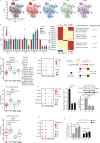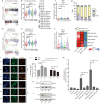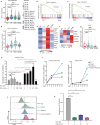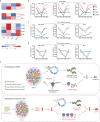Decoding the pathogenesis of Diamond-Blackfan anemia using single-cell RNA-seq
- PMID: 35534476
- PMCID: PMC9085895
- DOI: 10.1038/s41421-022-00389-z
Decoding the pathogenesis of Diamond-Blackfan anemia using single-cell RNA-seq
Abstract
Ribosomal protein dysfunction causes diverse human diseases, including Diamond-Blackfan anemia (DBA). Despite the universal need for ribosomes in all cell types, the mechanisms underlying ribosomopathies, which are characterized by tissue-specific defects, are still poorly understood. In the present study, we analyzed the transcriptomes of single purified erythroid progenitors isolated from the bone marrow of DBA patients. These patients were categorized into untreated, glucocorticoid (GC)-responsive and GC-non-responsive groups. We found that erythroid progenitors from untreated DBA patients entered S-phase of the cell cycle under considerable duress, resulting in replication stress and the activation of P53 signaling. In contrast, cell cycle progression was inhibited through induction of the type 1 interferon pathway in treated, GC-responsive patients, but not in GC-non-responsive patients. Notably, a low dose of interferon alpha treatment stimulated the production of erythrocytes derived from DBA patients. By linking the innately shorter cell cycle of erythroid progenitors to DBA pathogenesis, we demonstrated that interferon-mediated cell cycle control underlies the clinical efficacy of glucocorticoids. Our study suggests that interferon administration may constitute a new alternative therapeutic strategy for the treatment of DBA. The trial was registered at www.chictr.org.cn as ChiCTR2000038510.
© 2022. The Author(s).
Conflict of interest statement
The authors declare no competing interests.
Figures






Similar articles
-
Single-cell profiling of human bone marrow progenitors reveals mechanisms of failing erythropoiesis in Diamond-Blackfan anemia.Sci Transl Med. 2021 Sep 8;13(610):eabf0113. doi: 10.1126/scitranslmed.abf0113. Epub 2021 Sep 8. Sci Transl Med. 2021. PMID: 34516827
-
Glucocorticoids improve erythroid progenitor maintenance and dampen Trp53 response in a mouse model of Diamond-Blackfan anaemia.Br J Haematol. 2015 Nov;171(4):517-29. doi: 10.1111/bjh.13632. Epub 2015 Aug 25. Br J Haematol. 2015. PMID: 26305041 Free PMC article.
-
Steroid resistance in Diamond Blackfan anemia associates with p57Kip2 dysregulation in erythroid progenitors.J Clin Invest. 2020 Apr 1;130(4):2097-2110. doi: 10.1172/JCI132284. J Clin Invest. 2020. PMID: 31961825 Free PMC article.
-
Ribosomopathies: how a common root can cause a tree of pathologies.Dis Model Mech. 2015 Sep;8(9):1013-26. doi: 10.1242/dmm.020529. Dis Model Mech. 2015. PMID: 26398160 Free PMC article. Review.
-
Progress towards mechanism-based treatment for Diamond-Blackfan anemia.ScientificWorldJournal. 2012;2012:184362. doi: 10.1100/2012/184362. Epub 2012 Apr 24. ScientificWorldJournal. 2012. PMID: 22619618 Free PMC article. Review.
Cited by
-
Deficiency of ribosomal protein S26, which is mutated in a subset of patients with Diamond Blackfan anemia, impairs erythroid differentiation.Front Genet. 2022 Dec 12;13:1045236. doi: 10.3389/fgene.2022.1045236. eCollection 2022. Front Genet. 2022. PMID: 36579335 Free PMC article.
-
Pseudouridine synthase 1 regulates erythropoiesis via transfer RNAs pseudouridylation and cytoplasmic translation.iScience. 2024 Feb 17;27(3):109265. doi: 10.1016/j.isci.2024.109265. eCollection 2024 Mar 15. iScience. 2024. PMID: 38450158 Free PMC article.
-
Single-cell RNA sequencing reveals abnormal transcriptome signature of erythroid progenitors in pure red cell aplasia.Genes Dis. 2023 Apr 5;11(1):49-52. doi: 10.1016/j.gendis.2023.03.002. eCollection 2024 Jan. Genes Dis. 2023. PMID: 37588205 Free PMC article. No abstract available.
-
Animal models of Diamond-Blackfan anemia: updates and challenges.Haematologica. 2023 May 1;108(5):1222-1231. doi: 10.3324/haematol.2022.282042. Haematologica. 2023. PMID: 36384250 Free PMC article. Review.
-
Disruption of mitochondrial energy metabolism is a putative pathogenesis of Diamond-Blackfan anemia.iScience. 2024 Feb 9;27(3):109172. doi: 10.1016/j.isci.2024.109172. eCollection 2024 Mar 15. iScience. 2024. PMID: 38414864 Free PMC article.
References
-
- Halperin DS, Freedman MH. Diamond-blackfan anemia: etiology, pathophysiology, and treatment. Am. J. Pediatr. Hematol. Oncol. 1989;11:380–394. - PubMed
Grants and funding
LinkOut - more resources
Full Text Sources
Research Materials
Miscellaneous

